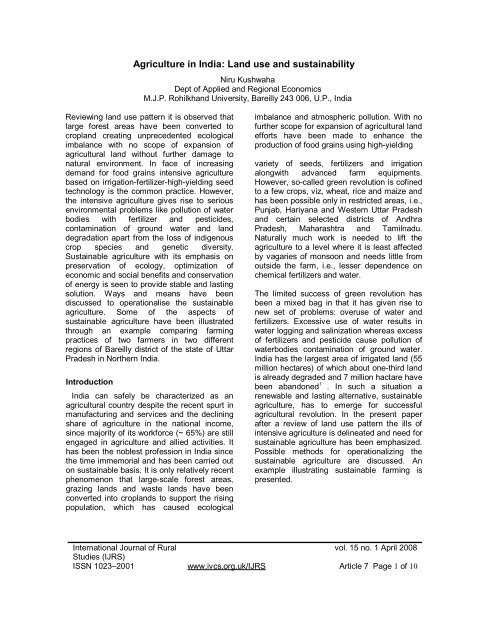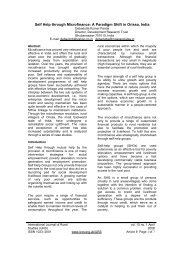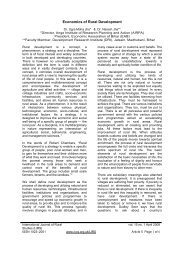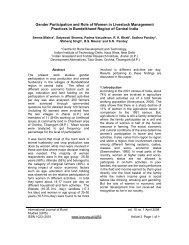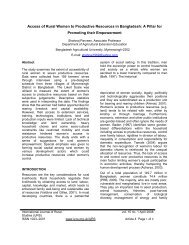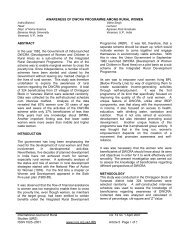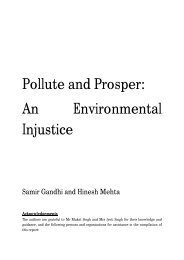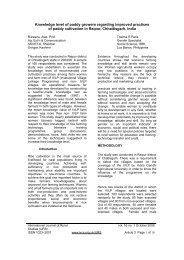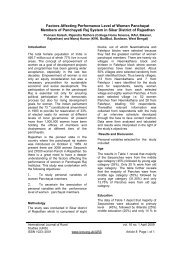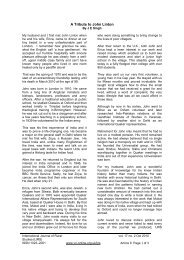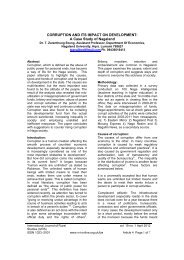7. Agriculture in India: Land use and sustainability - Volunteers for ...
7. Agriculture in India: Land use and sustainability - Volunteers for ...
7. Agriculture in India: Land use and sustainability - Volunteers for ...
Create successful ePaper yourself
Turn your PDF publications into a flip-book with our unique Google optimized e-Paper software.
<strong>Agriculture</strong> <strong>in</strong> <strong>India</strong>: <strong>L<strong>and</strong></strong> <strong>use</strong> <strong>and</strong> susta<strong>in</strong>ability<br />
Niru Kushwaha<br />
Dept of Applied <strong>and</strong> Regional Economics<br />
M.J.P. Rohilkh<strong>and</strong> University, Bareilly 243 006, U.P., <strong>India</strong><br />
Review<strong>in</strong>g l<strong>and</strong> <strong>use</strong> pattern it is observed that<br />
large <strong>for</strong>est areas have been converted to<br />
cropl<strong>and</strong> creat<strong>in</strong>g unprecedented ecological<br />
imbalance with no scope of expansion of<br />
agricultural l<strong>and</strong> without further damage to<br />
natural environment. In face of <strong>in</strong>creas<strong>in</strong>g<br />
dem<strong>and</strong> <strong>for</strong> food gra<strong>in</strong>s <strong>in</strong>tensive agriculture<br />
based on irrigation-fertilizer-high-yield<strong>in</strong>g seed<br />
technology is the common practice. However,<br />
the <strong>in</strong>tensive agriculture gives rise to serious<br />
environmental problems like pollution of water<br />
bodies with fertilizer <strong>and</strong> pesticides,<br />
contam<strong>in</strong>ation of ground water <strong>and</strong> l<strong>and</strong><br />
degradation apart from the loss of <strong>in</strong>digenous<br />
crop species <strong>and</strong> genetic diversity.<br />
Susta<strong>in</strong>able agriculture with its emphasis on<br />
preservation of ecology, optimization of<br />
economic <strong>and</strong> social benefits <strong>and</strong> conservation<br />
of energy is seen to provide stable <strong>and</strong> last<strong>in</strong>g<br />
solution. Ways <strong>and</strong> means have been<br />
discussed to operationalise the susta<strong>in</strong>able<br />
agriculture. Some of the aspects of<br />
susta<strong>in</strong>able agriculture have been illustrated<br />
through an example compar<strong>in</strong>g farm<strong>in</strong>g<br />
practices of two farmers <strong>in</strong> two different<br />
regions of Bareilly district of the state of Uttar<br />
Pradesh <strong>in</strong> Northern <strong>India</strong>.<br />
Introduction<br />
<strong>India</strong> can safely be characterized as an<br />
agricultural country despite the recent spurt <strong>in</strong><br />
manufactur<strong>in</strong>g <strong>and</strong> services <strong>and</strong> the decl<strong>in</strong><strong>in</strong>g<br />
share of agriculture <strong>in</strong> the national <strong>in</strong>come,<br />
s<strong>in</strong>ce majority of its work<strong>for</strong>ce (~ 65%) are still<br />
engaged <strong>in</strong> agriculture <strong>and</strong> allied activities. It<br />
has been the noblest profession <strong>in</strong> <strong>India</strong> s<strong>in</strong>ce<br />
the time immemorial <strong>and</strong> has been carried out<br />
on susta<strong>in</strong>able basis. It is only relatively recent<br />
phenomenon that large-scale <strong>for</strong>est areas,<br />
graz<strong>in</strong>g l<strong>and</strong>s <strong>and</strong> waste l<strong>and</strong>s have been<br />
converted <strong>in</strong>to cropl<strong>and</strong>s to support the ris<strong>in</strong>g<br />
population, which has ca<strong>use</strong>d ecological<br />
imbalance <strong>and</strong> atmospheric pollution. With no<br />
further scope <strong>for</strong> expansion of agricultural l<strong>and</strong><br />
ef<strong>for</strong>ts have been made to enhance the<br />
production of food gra<strong>in</strong>s us<strong>in</strong>g high-yield<strong>in</strong>g<br />
variety of seeds, fertilizers <strong>and</strong> irrigation<br />
alongwith advanced farm equipments.<br />
However, so-called green revolution is cof<strong>in</strong>ed<br />
to a few crops, viz, wheat, rice <strong>and</strong> maize <strong>and</strong><br />
has been possible only <strong>in</strong> restricted areas, i.e.,<br />
Punjab, Hariyana <strong>and</strong> Western Uttar Pradesh<br />
<strong>and</strong> certa<strong>in</strong> selected districts of Andhra<br />
Pradesh, Maharashtra <strong>and</strong> Tamilnadu.<br />
Naturally much work is needed to lift the<br />
agriculture to a level where it is least affected<br />
by vagaries of monsoon <strong>and</strong> needs little from<br />
outside the farm, i.e., lesser dependence on<br />
chemical fertilizers <strong>and</strong> water.<br />
The limited success of green revolution has<br />
been a mixed bag <strong>in</strong> that it has given rise to<br />
new set of problems: over<strong>use</strong> of water <strong>and</strong><br />
fertilizers. Excessive <strong>use</strong> of water results <strong>in</strong><br />
water logg<strong>in</strong>g <strong>and</strong> sal<strong>in</strong>ization whereas excess<br />
of fertilizers <strong>and</strong> pesticide ca<strong>use</strong> pollution of<br />
waterbodies contam<strong>in</strong>ation of ground water.<br />
<strong>India</strong> has the largest area of irrigated l<strong>and</strong> (55<br />
million hectares) of which about one-third l<strong>and</strong><br />
is already degraded <strong>and</strong> 7 million hactare have<br />
been ab<strong>and</strong>oned 1 . In such a situation a<br />
renewable <strong>and</strong> last<strong>in</strong>g alternative, susta<strong>in</strong>able<br />
agriculture, has to emerge <strong>for</strong> successful<br />
agricultural revolution. In the present paper<br />
after a review of l<strong>and</strong> <strong>use</strong> pattern the ills of<br />
<strong>in</strong>tensive agriculture is del<strong>in</strong>eated <strong>and</strong> need <strong>for</strong><br />
susta<strong>in</strong>able agriculture has been emphasized.<br />
Possible methods <strong>for</strong> operationaliz<strong>in</strong>g the<br />
susta<strong>in</strong>able agriculture are discussed. An<br />
example illustrat<strong>in</strong>g susta<strong>in</strong>able farm<strong>in</strong>g is<br />
presented.<br />
International Journal of Rural<br />
vol. 15 no. 1 April 2008<br />
Studies (IJRS)<br />
ISSN 1023–2001 www.ivcs.org.uk/IJRS Article 7 Page 1 of 10
<strong>L<strong>and</strong></strong> Use Pattern<br />
Of different <strong>use</strong>s of l<strong>and</strong>---<strong>for</strong>ests, pastures,<br />
human habitations, <strong>and</strong> various economic<br />
activities agriculture is the prime one <strong>and</strong><br />
most important <strong>for</strong> the survival of the<br />
mank<strong>in</strong>d.<br />
At present <strong>India</strong> has 23% <strong>for</strong>est cover, 3%<br />
pastures <strong>and</strong> graz<strong>in</strong>g l<strong>and</strong>, 46% area is<br />
under agricultural <strong>use</strong>, 14% l<strong>and</strong> is barren,<br />
6% l<strong>and</strong> is cultivable waste l<strong>and</strong> <strong>and</strong><br />
rema<strong>in</strong><strong>in</strong>g 8% is fallow l<strong>and</strong> 2 . Compared to<br />
<strong>India</strong> situation, <strong>for</strong>ests cover 30% of total<br />
l<strong>and</strong> area of the world, 26% are pastures<br />
<strong>and</strong> graz<strong>in</strong>g l<strong>and</strong>s <strong>and</strong> only about 11% of<br />
l<strong>and</strong> is <strong>use</strong>d <strong>for</strong> agriculture. The rema<strong>in</strong><strong>in</strong>g<br />
l<strong>and</strong> about 33% are marshy l<strong>and</strong>, desert,<br />
scrub <strong>for</strong>ests, bare rocks, ice <strong>and</strong> urban<br />
areas. About one-third of this l<strong>and</strong>, i.e., 11%<br />
is devoid of any plant cover <strong>and</strong> is<br />
completely barren 3 . Though the deserts <strong>and</strong><br />
other unproductive l<strong>and</strong>s are generally<br />
unsuitable <strong>for</strong> <strong>in</strong>tensive human <strong>use</strong>, they are<br />
important <strong>in</strong> biogeochemical cycles <strong>and</strong> act<br />
as a ref<strong>use</strong> <strong>for</strong> biological diversity.<br />
The proportion of l<strong>and</strong> area under<br />
agricultural <strong>use</strong> <strong>in</strong> <strong>India</strong> (46%) is much large<br />
compared to world (11%). Accord<strong>in</strong>g to<br />
some agricultural experts about half of the<br />
<strong>for</strong>ests <strong>in</strong> Africa <strong>and</strong> graz<strong>in</strong>g l<strong>and</strong>s <strong>in</strong> South<br />
America could be converted to cropl<strong>and</strong>s if<br />
proper <strong>in</strong>puts of water, fertilizer, erosion<br />
control <strong>and</strong> farm equipments are there. This<br />
could feed much larger population but then a<br />
susta<strong>in</strong>ed <strong>in</strong>tensive agriculture could give<br />
rise to serious environmental <strong>and</strong> social<br />
problems 3 . The area under agriculture has<br />
<strong>in</strong>creased from 118.7 million hectares (39%)<br />
<strong>in</strong> 1950-51 to 142 million hectares <strong>in</strong> 1995-<br />
96. This <strong>in</strong>crease <strong>in</strong> agricultural l<strong>and</strong> is<br />
largely as a result of clearance of <strong>for</strong>ests<br />
under population pressure. Accord<strong>in</strong>g to a<br />
conservative estimate de<strong>for</strong>estation has<br />
been go<strong>in</strong>g on at an alarm<strong>in</strong>g rate of 1.3 to<br />
1.5 million hectares every year through the<br />
nexus between <strong>for</strong>est officials <strong>and</strong> timber<br />
contractors. Himalayan <strong>for</strong>ests are likely to<br />
disappear completely <strong>in</strong> next 30 to 35 years<br />
if the cont<strong>in</strong>u<strong>in</strong>g de<strong>for</strong>estation is not checked<br />
immediately. Similarly <strong>for</strong>ests are be<strong>in</strong>g<br />
cleared <strong>in</strong> Western Ghats <strong>and</strong> Eastern<br />
Ghats.<br />
Large-scale destruction of <strong>for</strong>ests <strong>in</strong> <strong>India</strong><br />
has to be seen <strong>in</strong> historical perspective.<br />
Dur<strong>in</strong>g the British rule large <strong>for</strong>est areas<br />
were cleared <strong>for</strong> agricultural <strong>use</strong>, s<strong>in</strong>ce the<br />
Government preferred extensive cultivation<br />
to ensure food production <strong>for</strong> ris<strong>in</strong>g<br />
population. The policy was convenient <strong>for</strong><br />
Government revenues from timber, which<br />
was also needed <strong>for</strong> railways <strong>in</strong> <strong>India</strong> <strong>and</strong><br />
U.K. Accord<strong>in</strong>g to a 1894 circular “wherever<br />
an effective dem<strong>and</strong> <strong>for</strong> cultivable l<strong>and</strong><br />
exists <strong>and</strong> can only be supplied by <strong>for</strong>est<br />
area, the l<strong>and</strong> should ord<strong>in</strong>arily be<br />
rel<strong>in</strong>quished without hesitation” 4 . After<br />
<strong>in</strong>dependence the old policy was<br />
discont<strong>in</strong>ued but by then large <strong>for</strong>est areas<br />
had been utilized <strong>for</strong> permanent cultivation<br />
creat<strong>in</strong>g a situation that threatened the<br />
physical <strong>and</strong> climatic balance of the country.<br />
This was the reason the new <strong>for</strong>est policy of<br />
1952 laid guidel<strong>in</strong>es that one-third of the<br />
geographical area of the country should be<br />
covered by <strong>for</strong>ests <strong>and</strong> trees, <strong>in</strong> which<br />
mounta<strong>in</strong>ous <strong>and</strong> hilly regions should have<br />
60 percent coverage while pla<strong>in</strong>s should<br />
have 20 percent coverage. However the<br />
said guidel<strong>in</strong>es have been followed only <strong>in</strong><br />
its breach <strong>and</strong> pace of de<strong>for</strong>estation has<br />
<strong>in</strong>tensified after <strong>in</strong>dependence. Thus<br />
between 1854 <strong>and</strong> 1952, i.e., roughly a span<br />
of a century be<strong>for</strong>e <strong>in</strong>dependence the <strong>for</strong>est<br />
cover came down from an estimated 40<br />
percent to 22 percent of the l<strong>and</strong> area, an<br />
annual decl<strong>in</strong>e of about 0.2 percent. But<br />
after <strong>in</strong>dependence between 1952 <strong>and</strong><br />
1988, i.e., <strong>in</strong> a short period of 36 years the<br />
<strong>for</strong>est cover had come down from 22<br />
percent to 12 percent of the l<strong>and</strong> area, an<br />
annual decl<strong>in</strong>e of 0.4 percent.<br />
Massive de<strong>for</strong>estation has resulted <strong>in</strong>to<br />
serious problems of environmental <strong>in</strong>stability<br />
<strong>and</strong> ecological imbalance <strong>in</strong>clud<strong>in</strong>g<br />
atmospheric pollution. Moreover, rapid<br />
International Journal of Rural<br />
vol. 15 no. 1 April 2008<br />
Studies (IJRS)<br />
ISSN 1023–2001 www.ivcs.org.uk/IJRS Article 7 Page 2 of 10
<strong>in</strong>crease <strong>in</strong> modern transport systems,<br />
m<strong>in</strong><strong>in</strong>g <strong>and</strong> quarry<strong>in</strong>g operations as well as<br />
<strong>in</strong>dustrial production have been creat<strong>in</strong>g<br />
atmospheric pollution. The greenho<strong>use</strong><br />
gases-carbon dioxide, nitrous oxide,<br />
methane <strong>and</strong> chlorofluorocarbons contribute<br />
significantly to the atmospheric pollution.<br />
Large-scale de<strong>for</strong>estation has exposed<br />
sensitive catchment areas <strong>in</strong> Himalayas <strong>and</strong><br />
other hilly areas to soil erosion. The run-off<br />
ra<strong>in</strong> water from denuded areas have<br />
disastrous effects on the cultivated l<strong>and</strong>s of<br />
the pla<strong>in</strong>s, ca<strong>use</strong> floods with massive<br />
siltation of rivers. Ganga is only second to<br />
Huang (yellow) river <strong>in</strong> Ch<strong>in</strong>a <strong>in</strong> silt carry<strong>in</strong>g;<br />
it carries 1455 million metric tons of mud to<br />
the Bay of Bengal every year 5 . Much of this<br />
sediment comes from the Himalayas. In the<br />
context of widespread soil erosion <strong>and</strong><br />
atmospheric pollution the <strong>for</strong>est policy of<br />
1988 6 has set a goal of one-third <strong>for</strong>est<br />
cover with priority to the objective of<br />
ensur<strong>in</strong>g environmental stability <strong>and</strong><br />
ma<strong>in</strong>tenance of ecological balance <strong>in</strong>clud<strong>in</strong>g<br />
atmospheric equilibrium. In hills the tree<br />
cover should be two-third of the area <strong>in</strong><br />
order to prevent erosion, l<strong>and</strong> degradation<br />
<strong>and</strong> to ensure stability of fragile ecosystem.<br />
By <strong>in</strong>creas<strong>in</strong>g the area of protective <strong>for</strong>ests,<br />
denudation <strong>in</strong> the catchment areas of rivers<br />
<strong>and</strong> streams can be controlled. Forests<br />
check the extension of s<strong>and</strong> dunes <strong>in</strong><br />
deserts <strong>and</strong> coastal tracts.<br />
Unlike <strong>for</strong>ests graz<strong>in</strong>g l<strong>and</strong>s are open<br />
spaces <strong>and</strong> are more attractive <strong>for</strong> human<br />
occupation. Often they are converted to<br />
cropl<strong>and</strong>s, urban areas <strong>and</strong> other hum<strong>and</strong>om<strong>in</strong>ated<br />
structures. Area under graz<strong>in</strong>g<br />
l<strong>and</strong>s has gradually decl<strong>in</strong>ed <strong>and</strong> has been<br />
converted to cropl<strong>and</strong>. Though graz<strong>in</strong>g l<strong>and</strong>s<br />
are 3% of total l<strong>and</strong> area, other l<strong>and</strong>s that<br />
are <strong>use</strong>d <strong>for</strong> graz<strong>in</strong>g (<strong>for</strong>est 23%, fallow l<strong>and</strong><br />
8%, barren 14%, <strong>and</strong> wastel<strong>and</strong> 6%) even if<br />
<strong>use</strong>d seasonally <strong>and</strong>/ or occasionally,<br />
together constitute more than half of the<br />
geographical area of the country. This l<strong>and</strong><br />
is <strong>use</strong>d <strong>for</strong> rais<strong>in</strong>g animals who provide us<br />
milk, meat <strong>and</strong> other valuables like wool etc.<br />
Some nomadic tribes who adjust to varied<br />
l<strong>and</strong> <strong>and</strong> climate conditions live by livestock<br />
only <strong>and</strong> produce h<strong>and</strong>some yields from<br />
harsh <strong>and</strong> <strong>in</strong>hospitable regions: Gujjars <strong>in</strong><br />
Garhwal Himalayas <strong>and</strong> Kashmir <strong>and</strong><br />
Bakerwals <strong>in</strong> Kashmir come <strong>in</strong> this category.<br />
While Gujjars tend buffalo <strong>and</strong> produce milk<br />
Bakerwals herd sheep <strong>and</strong> goats provid<strong>in</strong>g<br />
valuable wool, milk <strong>and</strong> meat. Camels <strong>in</strong><br />
desert area feed on thorny bushes <strong>and</strong><br />
provide <strong>use</strong>ful service. Although graz<strong>in</strong>g<br />
l<strong>and</strong>s appear to be uni<strong>for</strong>m <strong>and</strong> monotonous<br />
they are quite rich <strong>in</strong> species help<strong>in</strong>g <strong>in</strong><br />
ma<strong>in</strong>ta<strong>in</strong><strong>in</strong>g ecological balance <strong>and</strong> diversity.<br />
Intensive <strong>Agriculture</strong><br />
As <strong>for</strong> agricultural l<strong>and</strong>, there is hardly scope<br />
<strong>for</strong> further expansion; on the contrary there<br />
has been marg<strong>in</strong>al decl<strong>in</strong>e <strong>in</strong> the crop area<br />
due to construction activities on prime<br />
agricultural l<strong>and</strong> on account of urban<br />
expansion <strong>and</strong> <strong>in</strong>dustrialization etc. As<br />
mentioned earlier, only 11 percent of the<br />
total l<strong>and</strong> area of the world is under<br />
cultivation, which is 1441 million hectare<br />
whereas <strong>in</strong> <strong>India</strong> cropl<strong>and</strong> area is 141 million<br />
hectare, which is 46 percent of the l<strong>and</strong> area<br />
of the country. At the world level another 40<br />
percent l<strong>and</strong> can be converted to cropl<strong>and</strong><br />
but much of this l<strong>and</strong> serves as a ref<strong>use</strong> <strong>for</strong><br />
cultural or biological diversity or be<strong>in</strong>g<br />
marg<strong>in</strong>al l<strong>and</strong>s suffer<strong>in</strong>g from constra<strong>in</strong>ts<br />
such as steep slopes, shallow soils, poor<br />
dra<strong>in</strong>age, tillage problems, low nutrient<br />
levels, excess soluble salts, or acidity only<br />
limited number of crops can be grown. Such<br />
l<strong>and</strong>s are already under cultivation <strong>in</strong> our<br />
country <strong>and</strong> with grow<strong>in</strong>g population the per<br />
capita availability of cropl<strong>and</strong> is bound to fall.<br />
In order to meet the food requirement of<br />
grow<strong>in</strong>g population the yield of the cropl<strong>and</strong><br />
must be <strong>in</strong>creased with the <strong>use</strong> of irrigation,<br />
fertilizer, pesticide <strong>and</strong> high- yield<strong>in</strong>g variety<br />
of seeds. Most of the develop<strong>in</strong>g countries<br />
have <strong>use</strong>d <strong>in</strong>tensive agriculture on exist<strong>in</strong>g<br />
l<strong>and</strong>s to meet their needs <strong>and</strong> <strong>India</strong> is no<br />
exception. However, the <strong>in</strong>tensive<br />
International Journal of Rural<br />
vol. 15 no. 1 April 2008<br />
Studies (IJRS)<br />
ISSN 1023–2001 www.ivcs.org.uk/IJRS Article 7 Page 3 of 10
agriculture based on irrigation, fertilizer,<br />
pesticides, high-yield<strong>in</strong>g varieties of seeds<br />
<strong>and</strong> advanced farm equipments has its own<br />
limitations <strong>and</strong> problems:<br />
• New high-yield<strong>in</strong>g varieties of seeds<br />
are really “high responders” rather<br />
than high yielder, i.e., with<br />
<strong>in</strong>creas<strong>in</strong>g amount of fertilizer <strong>and</strong><br />
water they respond more efficiently<br />
<strong>and</strong> yield is higher than other<br />
varieties. Under poor conditions, i.e.,<br />
<strong>in</strong> absence of sufficient water <strong>and</strong><br />
fertilizer these seeds do not give<br />
higher yield compared to traditional<br />
crops 7 . It is presumed that high<br />
dose of fertilizers ca<strong>use</strong> faster<br />
depletion of soil nutrients <strong>and</strong> <strong>in</strong> a<br />
way we are m<strong>in</strong><strong>in</strong>g soil, s<strong>in</strong>ce<br />
nutrients are be<strong>in</strong>g <strong>use</strong>d much faster<br />
than they are be<strong>in</strong>g replaced. On<br />
the other h<strong>and</strong>, with the <strong>use</strong> of<br />
organic manures the soil nutrients<br />
are ma<strong>in</strong>ta<strong>in</strong>ed <strong>for</strong> longer periods.<br />
• In the context of crop breed<strong>in</strong>g the<br />
question has been raised whether<br />
new varieties will cont<strong>in</strong>ue to be<br />
produced that will ma<strong>in</strong>ta<strong>in</strong> these<br />
high-yields. Throughout the world<br />
native crop varieties are be<strong>in</strong>g<br />
replaced by these new crops <strong>and</strong><br />
genetic resource available to<br />
breeders is be<strong>in</strong>g seriously<br />
dim<strong>in</strong>ished. Many <strong>in</strong>digenous crop<br />
species have been lost.<br />
• With only new hybrid varieties of<br />
seeds be<strong>in</strong>g sown we are fast los<strong>in</strong>g<br />
genetic diversity, which was source<br />
of major crops.<br />
• With a s<strong>in</strong>gle crop variety all over<br />
the fields there is real risk, s<strong>in</strong>ce<br />
some disease might damage the<br />
entire crop result<strong>in</strong>g <strong>in</strong> complete<br />
dislocation of production.<br />
• Poor farmers cannot af<strong>for</strong>d high<br />
value farm equipments, fertilizer,<br />
pesticides <strong>and</strong> high- yield<strong>in</strong>g seeds<br />
<strong>and</strong> thus only rich farmers are able<br />
to participate <strong>in</strong> the green revolution.<br />
Further, with surplus production the<br />
prices come down mak<strong>in</strong>g poor<br />
farmers worse off than be<strong>for</strong>e.<br />
• Most farmers over water the fields<br />
often result<strong>in</strong>g <strong>in</strong> water logg<strong>in</strong>g.<br />
Irrigation with sal<strong>in</strong>e water results <strong>in</strong><br />
sal<strong>in</strong>ization that kill plants. Irrigation<br />
problems are major source of l<strong>and</strong><br />
degradation <strong>and</strong> crop losses.<br />
• Often farmers are unaware of<br />
nutrient content of the soil <strong>in</strong> their<br />
field or the need of the crops <strong>and</strong><br />
<strong>use</strong> excess amount of fertilizers.<br />
This is not only wastage of the<br />
money but is major ca<strong>use</strong> of the<br />
environmental degradation. Fertilizer<br />
from fields jo<strong>in</strong> the run-off <strong>and</strong><br />
pollute the aquatic ecosystem.<br />
Nitrate levels <strong>in</strong> groundwater have<br />
been found to be too high to be safe<br />
<strong>in</strong> many places where <strong>in</strong>tensive<br />
agriculture is practiced.<br />
In view of the above po<strong>in</strong>ts it is evident that<br />
the <strong>in</strong>tensive agriculture cannot be susta<strong>in</strong>ed<br />
without creat<strong>in</strong>g serious environmental <strong>and</strong><br />
social problems. It is true that <strong>in</strong> many<br />
develop<strong>in</strong>g countries <strong>and</strong> <strong>in</strong> many regions of<br />
our own country <strong>in</strong>tensive agriculture can be<br />
<strong>use</strong>d to <strong>in</strong>crease the farm production. But<br />
then it is clear that the <strong>in</strong>tensive agriculture<br />
does not provide the last<strong>in</strong>g solution <strong>and</strong> we<br />
should th<strong>in</strong>k of the ways to make agriculture<br />
more stable <strong>and</strong> renewable. Thus the real<br />
answer is susta<strong>in</strong>able agriculture 8,9 .<br />
Susta<strong>in</strong>able <strong>Agriculture</strong><br />
The susta<strong>in</strong>able agriculture may be def<strong>in</strong>ed<br />
as any set of agronomic practices that are<br />
economically viable, environmentally safe,<br />
<strong>and</strong> socially acceptable.<br />
If a cropp<strong>in</strong>g system requires large <strong>in</strong>puts of<br />
fertilizer that leak from the system to pollute<br />
ground water, dr<strong>in</strong>k<strong>in</strong>g supplies <strong>and</strong> distant<br />
coastal fisheries, the system may be<br />
International Journal of Rural<br />
vol. 15 no. 1 April 2008<br />
Studies (IJRS)<br />
ISSN 1023–2001 www.ivcs.org.uk/IJRS Article 7 Page 4 of 10
susta<strong>in</strong>able economically as the long-term<br />
supply of fertilizer is stable <strong>and</strong> the<br />
economic cost of fertilizer is easily borne by<br />
larger gra<strong>in</strong> production but it is not<br />
susta<strong>in</strong>able environmentally or socially,<br />
s<strong>in</strong>ce it does not cover the cost of<br />
environmental damage or social costs. The<br />
organic agriculture foc<strong>use</strong>s on “liv<strong>in</strong>g soil”,<br />
on optimiz<strong>in</strong>g the <strong>use</strong> of biological<br />
processes <strong>and</strong> on avoid<strong>in</strong>g the <strong>use</strong> of<br />
synthetic chemicals <strong>and</strong> fertilizers.<br />
Advocates of susta<strong>in</strong>able agriculture agree<br />
with biological focus <strong>and</strong> hope to reduce but<br />
not necessarily elim<strong>in</strong>ate chemical <strong>use</strong>. In<br />
the context of susta<strong>in</strong>able agriculture<br />
another term “alternative agriculture” has<br />
been prom<strong>in</strong>ently <strong>use</strong>d. Def<strong>in</strong>ition of<br />
alternative agriculture sheds much light on<br />
operational aspects of susta<strong>in</strong>able<br />
agriculture. Any food or fiber production that<br />
has<br />
• a more thorough <strong>in</strong>corporation of<br />
natural processes,<br />
• reduced <strong>use</strong> of off-farm <strong>in</strong>puts with less<br />
harm to environment <strong>and</strong> consumers,<br />
• a more productive <strong>use</strong> of biological <strong>and</strong><br />
genetic potential of plants <strong>and</strong> animals,<br />
• a better match between cropp<strong>in</strong>g<br />
patterns <strong>and</strong> the physical capacity of<br />
l<strong>and</strong>s <strong>and</strong>,<br />
• an improved emphasis on conservation<br />
of soil, water, energy <strong>and</strong> biological<br />
resources, is def<strong>in</strong>ed as alternative<br />
agriculture.<br />
The normal agricultural practices us<strong>in</strong>g<br />
irrigation, chemical fertilizer, pesticides <strong>and</strong><br />
high-yield<strong>in</strong>g variety of seeds is called<br />
conventional agriculture. With <strong>in</strong>creas<strong>in</strong>g<br />
<strong>use</strong> of chemical fertilizers <strong>and</strong> pesticides the<br />
conventional agriculture is major source of<br />
pollution of <strong>in</strong>l<strong>and</strong> water bodies <strong>and</strong> coastal<br />
seas. There has been grow<strong>in</strong>g criticism of<br />
conventional agriculture <strong>for</strong> its side effects,<br />
the “external costs” which impact<br />
communities, the environment, <strong>and</strong> human<br />
health.<br />
As <strong>for</strong> <strong>in</strong>dicators of susta<strong>in</strong>ability there is no<br />
s<strong>in</strong>gle prescription. Susta<strong>in</strong>able practices will<br />
vary by cropp<strong>in</strong>g system, local environment<br />
<strong>and</strong> socio-economic system. Still,<br />
experience tells us that locally susta<strong>in</strong>able<br />
systems tend to be more resource<br />
conservative than less susta<strong>in</strong>able system<br />
<strong>and</strong> tend to rely less on external <strong>in</strong>puts <strong>and</strong><br />
more on <strong>in</strong>ternal ecosystem services.<br />
Resource Conservation:<br />
One very important ecosystem resources,<br />
soil organic matter, decl<strong>in</strong>es rapidly <strong>in</strong><br />
almost all cropp<strong>in</strong>g systems follow<strong>in</strong>g <strong>in</strong>itial<br />
cultivation- typically 40-60 percent of orig<strong>in</strong>al<br />
values with<strong>in</strong> a few decades. Soil organic<br />
matter is valuable resource, provid<strong>in</strong>g<br />
habitat <strong>and</strong> energy <strong>for</strong> soil organism, a soil<br />
structure favorable <strong>for</strong> plant growth <strong>and</strong><br />
water retention <strong>and</strong> a chemical structure<br />
favorable <strong>for</strong> nutrient retention.<br />
Cropp<strong>in</strong>g practices that conserve or<br />
enhance soil organic matter buildup will<br />
<strong>in</strong>variably enhance environmental <strong>and</strong> often<br />
the economic susta<strong>in</strong>ability of cropp<strong>in</strong>g<br />
systems. Crops grown <strong>in</strong> high organic matter<br />
soils have a better water <strong>and</strong> nutrient<br />
environment <strong>and</strong> require less <strong>and</strong> fewer<br />
external <strong>in</strong>puts <strong>for</strong> the same productivity.<br />
High-organic matter soils help to check soil<br />
erosion <strong>and</strong> run-off <strong>and</strong> thus better protects<br />
downstream environments from organic<br />
impact. There<strong>for</strong>e, cropp<strong>in</strong>g practices that<br />
conserve soil organic matter can be<br />
considered more susta<strong>in</strong>able than those that<br />
do not. Often, however, there are trade-offs<br />
that require conservation ef<strong>for</strong>ts to be<br />
evaluated <strong>in</strong> the overall context of<br />
susta<strong>in</strong>ability. For example, conservation<br />
tillage typically slows or stops soil organic<br />
matter loss <strong>and</strong> thus can be considered a<br />
resource-conserv<strong>in</strong>g, susta<strong>in</strong>able cropp<strong>in</strong>g<br />
practice. However, <strong>in</strong> absence of tillage we<br />
need herbicides to control weeds that have<br />
environmental <strong>and</strong> economic cost different<br />
from those from tillage. Ideally, such trade-<br />
International Journal of Rural<br />
vol. 15 no. 1 April 2008<br />
Studies (IJRS)<br />
ISSN 1023–2001 www.ivcs.org.uk/IJRS Article 7 Page 5 of 10
offs can be m<strong>in</strong>imized. Each cropp<strong>in</strong>g<br />
practice must be evaluated <strong>in</strong> the light of<br />
overall susta<strong>in</strong>ability of a system.<br />
Ecosystem Services:<br />
Farms provide ecosystem services to<br />
organisms with<strong>in</strong> the farm<strong>in</strong>g system as well<br />
as to organisms <strong>in</strong> the surround<strong>in</strong>g<br />
l<strong>and</strong>scape <strong>and</strong> to local communities.<br />
Services such as poll<strong>in</strong>ation, water retention<br />
<strong>and</strong> ground water recharge, a particular light<br />
environment, or food sources are <strong>in</strong>tegral to<br />
the function<strong>in</strong>g of healthy ecosystems. In<br />
modern cropp<strong>in</strong>g systems many services<br />
provided by orig<strong>in</strong>al ecosystems prior to its<br />
conversion to agriculture have been<br />
suppressed or ignored <strong>in</strong> favour of services<br />
provided by external <strong>in</strong>puts. In a nitrogenpoor<br />
native ecosystem, biological nitrogen<br />
fixation by native legumes such as “arhar”<br />
(yellow pulse) might be a pr<strong>in</strong>cipal source of<br />
fixed nitrogen; modern cropp<strong>in</strong>g systems<br />
rely almost exclusively on <strong>in</strong>dustrially fixed<br />
nitrogen provided as <strong>in</strong>organic fertilizer. In a<br />
native or unmanaged system, <strong>in</strong>sect<br />
herbivore is suppressed largely by plant<br />
diversity <strong>and</strong> structural complexity that<br />
enable <strong>in</strong>sect <strong>and</strong> vertebrate predators to<br />
keep the plant pests at bay. In modern<br />
practices <strong>in</strong>sect pests are controlled with<br />
<strong>in</strong>secticides that also kill <strong>in</strong>sect predators.<br />
Manag<strong>in</strong>g a cropp<strong>in</strong>g system with legumes<br />
or greater plant diversity would allow the<br />
ecosystem to provide more of the services<br />
that are provided by external <strong>in</strong>puts.<br />
Similarly animal manure produced on farm<br />
<strong>and</strong> recycled to the field can replace<br />
fertilizer <strong>use</strong>. Agricultural research is help<strong>in</strong>g<br />
to identify the ways <strong>in</strong> which management<br />
can add ecosystem services that both<br />
enhance resource availability <strong>and</strong> reduce<br />
environmental costs of agriculture. At<br />
societal scale the farms provide valuable<br />
services to neighbor<strong>in</strong>g communities.<br />
Examples of susta<strong>in</strong>able cropp<strong>in</strong>g systems<br />
are provided by bush-fallow rotation systems<br />
<strong>and</strong> mixed farm<strong>in</strong>g systems. Be<strong>for</strong>e the<br />
advent of cont<strong>in</strong>uous cropp<strong>in</strong>g systems<br />
bush-fallow rotation system was <strong>in</strong>digenous<br />
to many cultures <strong>and</strong> “Jhum cultivation” <strong>in</strong><br />
North-East is still <strong>use</strong>d today <strong>in</strong> certa<strong>in</strong><br />
pockets. In these systems a plot is cleared<br />
of native vegetation <strong>and</strong> is cropped. When<br />
nutrients are depleted after few crops the<br />
plot is ab<strong>and</strong>oned to “bush-fallow” <strong>and</strong><br />
another plot is cleared <strong>and</strong> cropped. With<br />
ris<strong>in</strong>g population this type of susta<strong>in</strong>able<br />
cropp<strong>in</strong>g has limited utility today.<br />
The mixed farm<strong>in</strong>g system has several<br />
production l<strong>in</strong>es with crops, trees, animals or<br />
comb<strong>in</strong>ations of crops <strong>and</strong> animals. Even<br />
now small l<strong>and</strong> owners requir<strong>in</strong>g a farm<br />
family self-reliance produce wide array of<br />
goods that is primarily to meet family <strong>and</strong><br />
local market needs <strong>for</strong> an ensured, year<br />
round supply of food, fuel <strong>and</strong> build<strong>in</strong>g<br />
materials. The diversity of l<strong>and</strong> <strong>use</strong> provides<br />
a range of ecosystem services, <strong>in</strong>clud<strong>in</strong>g<br />
precipitation management, ground water<br />
recharge, wildlife habitat, an environment<br />
usually conducive to adequate pest-predator<br />
balance, <strong>and</strong> some mitigation of harsh<br />
climate conditions. The mixed plant<br />
community provides shade, w<strong>in</strong>d protection,<br />
privacy, <strong>and</strong> many other, often seasonal,<br />
assorted products <strong>and</strong> services. The range<br />
of outputs has recently been called the<br />
multifunctional character of agricultural l<strong>and</strong><br />
(FAO, 1999) 10 . In areas with high density of<br />
population, small farms <strong>and</strong> the need <strong>for</strong><br />
produc<strong>in</strong>g a wide range of products <strong>in</strong> often<br />
marg<strong>in</strong>al production environments, a very<br />
diverse type of farm enterprise mix is<br />
common. In areas with heavy ra<strong>in</strong>fall trees<br />
are part of native vegetation <strong>and</strong> may be a<br />
very important part of farm productivity.<br />
Usually animals are the part of the<br />
enterprise beca<strong>use</strong> they consume farm<br />
residues <strong>and</strong> add significantly to farm<br />
productivity.<br />
In most of the country there is little area of<br />
undisturbed <strong>for</strong>est, <strong>and</strong> only a few exclusive<br />
animal farms are there. In many parts where<br />
modest levels of ra<strong>in</strong>fall are there <strong>and</strong>/ or <strong>in</strong><br />
International Journal of Rural<br />
vol. 15 no. 1 April 2008<br />
Studies (IJRS)<br />
ISSN 1023–2001 www.ivcs.org.uk/IJRS Article 7 Page 6 of 10
w<strong>in</strong>ter months fuel <strong>for</strong> cook<strong>in</strong>g <strong>and</strong> heat<strong>in</strong>g<br />
becomes a problem especially <strong>for</strong> poor<br />
ho<strong>use</strong>holds. Often trees are cut <strong>for</strong> firewood,<br />
farm residues <strong>and</strong> animal residues are<br />
burned. This leads to resource degradation<br />
<strong>and</strong> loss of production potential. The system<br />
rapidly loses crop nutrient hold<strong>in</strong>g <strong>and</strong><br />
recycl<strong>in</strong>g capacity <strong>and</strong> its ability to <strong>in</strong>tercept<br />
<strong>and</strong> reta<strong>in</strong> ra<strong>in</strong>fall decreases.<br />
We conclude that susta<strong>in</strong>able agriculture is<br />
far more preferable if we take <strong>in</strong>to account<br />
the resource conserv<strong>in</strong>g potential <strong>and</strong><br />
ecosystem services provided by it <strong>and</strong> the<br />
grave environmental cost paid by society <strong>in</strong><br />
conventional farm<strong>in</strong>g system based on<br />
water-fertilizer- high -yield<strong>in</strong>g seed<br />
technology.<br />
Susta<strong>in</strong>able farm practices: An Example:<br />
In order to illustrate some aspects of<br />
susta<strong>in</strong>able agriculture we compare the<br />
farm<strong>in</strong>g practices of two farmers engaged <strong>in</strong><br />
production of rice <strong>in</strong> two different regions of<br />
Bareilly district of the state Utter Pradesh <strong>in</strong><br />
northern <strong>India</strong>: Faridpur Tehsil <strong>and</strong> Baheri<br />
Tehsil. While Faridpur is situated <strong>in</strong> southern<br />
part of the district where soil is loamy <strong>and</strong><br />
irrigation is largely dependent on ground<br />
water extracted by tube wells <strong>and</strong> pump sets<br />
Baheri is situated <strong>in</strong> the northern part, the<br />
Tarai belt border<strong>in</strong>g Uttranchal, the hill state<br />
newly carved from Utter Pradesh. Soil <strong>in</strong><br />
Baheri region is largely black <strong>and</strong> much<br />
more fertile compared to Faridpur <strong>and</strong><br />
irrigation is ma<strong>in</strong>ly based on canal water<br />
obta<strong>in</strong>ed from river Bagul com<strong>in</strong>g from<br />
Uttranchal. In Table I we present the costbenefit<br />
analysis of rice production based on<br />
data obta<strong>in</strong>ed through private conversation<br />
with the concerned farmers. Apart from the<br />
explicit <strong>in</strong><strong>for</strong>mation presented <strong>in</strong> the table<br />
what is not obvious but revealed dur<strong>in</strong>g<br />
private conversation is the fact that farmer <strong>in</strong><br />
Faridpur (A) with l<strong>and</strong> hold<strong>in</strong>g of 1.33 acre is<br />
essentially a marg<strong>in</strong>al farmer dependent on<br />
hired farm equipments, irrigation water <strong>and</strong><br />
carries out most of farm operations himself<br />
<strong>and</strong> through farm labourers the one <strong>in</strong><br />
Baheri (B) with a l<strong>and</strong> hold<strong>in</strong>g of <strong>7.</strong>5 acre is<br />
a medium farmer, who owns a tractor but<br />
depends on hired comb<strong>in</strong>e harvest<strong>in</strong>g<br />
mach<strong>in</strong>e plus hired labourers <strong>for</strong> different<br />
farm operations <strong>and</strong> clears his field of<br />
herbicide solution after two days of its<br />
application be<strong>for</strong>e plant<strong>in</strong>g of seedl<strong>in</strong>gs<br />
otherwise it would kill the ma<strong>in</strong> crop also.<br />
The cost of different farm<strong>in</strong>g operations are<br />
as per prevail<strong>in</strong>g market rates <strong>in</strong> the regions<br />
though some of the operations might have<br />
been per<strong>for</strong>med by the farmers themselves<br />
<strong>and</strong> not hired from the specialized service<br />
providers; thus, <strong>for</strong> <strong>in</strong>stance, farmer A hires<br />
tractor <strong>for</strong> plough<strong>in</strong>g the field but does most<br />
of other operations himself <strong>and</strong> through his<br />
family members whereas farmer B <strong>use</strong>s his<br />
own tractor <strong>for</strong> plough<strong>in</strong>g but hires farm<br />
labourers <strong>for</strong> other operations. The<br />
presentation of cost based on market rates<br />
facilitates a direct comparison between the<br />
two.<br />
A perusal of the table I reveals that both the<br />
farmers <strong>use</strong> essentially <strong>in</strong>tensive agriculture<br />
us<strong>in</strong>g irrigation-fertilizer-high-yield<strong>in</strong>g seed<br />
technology. Apart from m<strong>in</strong>or differences <strong>in</strong><br />
different farm<strong>in</strong>g operations <strong>and</strong> costs<br />
<strong>in</strong>curred three basic differences between the<br />
two are:<br />
(i) Irrigation: Farmer A <strong>use</strong>s underground<br />
water extracted by tubewell on hourly rental<br />
basis <strong>and</strong> has to irrigate the field 5-6 times,<br />
after <strong>in</strong>itial heavy irrigation at the time of<br />
sow<strong>in</strong>g when there are no ra<strong>in</strong>s at all;<br />
however the actual irrigation <strong>use</strong>d depends<br />
on the amount <strong>and</strong> tim<strong>in</strong>g of ra<strong>in</strong>fall <strong>in</strong> the<br />
area. On the other h<strong>and</strong> farmer B <strong>use</strong>s canal<br />
water <strong>for</strong> irrigation throughout the duration of<br />
the crop on the basis of nom<strong>in</strong>al charge of<br />
Rs. 60 per acre. There is possibility of over<br />
<strong>use</strong> of water by farmer B result<strong>in</strong>g <strong>in</strong><br />
waterlogg<strong>in</strong>g, s<strong>in</strong>ce water is available almost<br />
free.<br />
(ii) Use of pesticides <strong>and</strong> herbicides:<br />
While farmer B <strong>use</strong>s pesticides to control<br />
pests <strong>and</strong> herbicides to get rid of unwanted<br />
International Journal of Rural<br />
vol. 15 no. 1 April 2008<br />
Studies (IJRS)<br />
ISSN 1023–2001 www.ivcs.org.uk/IJRS Article 7 Page 7 of 10
weeds from the field the farmer A does not<br />
<strong>use</strong> these harmful chemicals. As a<br />
consequence farmer A has to <strong>in</strong>cur an<br />
expense of Rs 1020 = per acre on hoe<strong>in</strong>g to<br />
extract weeds manually <strong>and</strong> suffers the risk<br />
of damages to the crop due to possible<br />
attack of pests. With the <strong>use</strong> of pesticides<br />
<strong>and</strong> herbicides at much lower cost (Rs 600=)<br />
farmer B gets rid of weeds <strong>and</strong> pests but <strong>in</strong><br />
the process he ca<strong>use</strong>s serious damage to<br />
environment by releas<strong>in</strong>g these chemicals <strong>in</strong><br />
the open to be carried off to waterbodies.<br />
(iii) Harvest<strong>in</strong>g: while A <strong>use</strong>s manual<br />
harvest<strong>in</strong>g B <strong>use</strong>s rented comb<strong>in</strong>e mach<strong>in</strong>e<br />
<strong>for</strong> this purpose <strong>and</strong> is somewhat<br />
economical sav<strong>in</strong>g Rs 420 = per acre<br />
compared to A. But due to manual<br />
harvest<strong>in</strong>g A gets hay which over<br />
compensates the costly manual harvest<strong>in</strong>g<br />
<strong>and</strong> at the time gets ga<strong>in</strong>ful employment <strong>for</strong><br />
himself <strong>and</strong> his family members <strong>and</strong> <strong>for</strong><br />
some other farm labourers too.<br />
We observe that farmer B gets better return<br />
compared to farmer A but B’s agricultural<br />
practice is not safe environmentally <strong>and</strong><br />
socially less acceptable. Thus the farm<br />
practices followed by A are much better on<br />
susta<strong>in</strong>ablility than that of B.<br />
As stated earlier, <strong>for</strong> susta<strong>in</strong>ability the <strong>use</strong> of<br />
animal manure is preferable to that of<br />
chemical fertilizers. S<strong>in</strong>ce manure is not<br />
available <strong>in</strong> sufficient amount <strong>and</strong> there<strong>for</strong>e<br />
any def<strong>in</strong>ite figure could not be made<br />
available but the experience of both the<br />
farmers tells us that the <strong>use</strong> of animal<br />
manure alongwith much reduced amount of<br />
fertilizers fetches much better yield <strong>and</strong> at<br />
the same time ensures ma<strong>in</strong>tenance of<br />
higher level of fertility <strong>for</strong> longer period. With<br />
almost universal acceptance <strong>and</strong> practice of<br />
conventional agriculture based on irrigationfertilizer-high-yield<strong>in</strong>g<br />
seed technology the<br />
local wisdom <strong>and</strong> experience calls <strong>for</strong><br />
periodic <strong>use</strong> of animal manure <strong>and</strong> crop<br />
rotation <strong>for</strong> susta<strong>in</strong>ability of yield as well as<br />
fertility of soil.<br />
We see that farmer A relies more on manual<br />
labour <strong>and</strong> ca<strong>use</strong>s lesser damage to<br />
environment by not us<strong>in</strong>g pesticides <strong>and</strong><br />
herbicides <strong>and</strong> thus captures the essence of<br />
susta<strong>in</strong>able agriculture. The practice of<br />
rely<strong>in</strong>g on manual labour not only creates<br />
additional jobs <strong>in</strong> rural areas it adds to<br />
energy conservation sav<strong>in</strong>g on crucial fossil<br />
fuels <strong>use</strong>d <strong>in</strong> farm equipments such as<br />
harvest<strong>in</strong>g mach<strong>in</strong>es. Not us<strong>in</strong>g pesticides A<br />
suffers possible damage to crops on<br />
account of pests attack while non <strong>use</strong> of<br />
herbicide <strong>for</strong>ces him to <strong>in</strong>cur additional cost<br />
on hoe<strong>in</strong>g but then it ensures the<br />
preservation of ecology <strong>and</strong> social benefits<br />
<strong>in</strong> terms of public health. Thus susta<strong>in</strong>able<br />
farm practice should attempt preservation of<br />
ecology, optimization of economic <strong>and</strong> social<br />
benefits, creation of additional jobs <strong>and</strong><br />
conservation of energy.<br />
The ma<strong>in</strong>stay of staple food <strong>in</strong> our country<br />
are wheat <strong>and</strong> rice <strong>and</strong> much of agricultural<br />
research <strong>and</strong> extension services have<br />
concentrated on these crops. The highyield<strong>in</strong>g<br />
improved varieties of seed require<br />
high doses of water <strong>and</strong> fertilizers,<br />
archetypical vehicle of green revolution.<br />
Concomitants of high doses of water <strong>and</strong><br />
fertilizers are environmental problems:<br />
waterlogg<strong>in</strong>g, sal<strong>in</strong>ization of soil, shortage of<br />
water, fall<strong>in</strong>g water table, contam<strong>in</strong>ation of<br />
underground water, <strong>and</strong> pollution of<br />
waterbodies with chemical fertilizers <strong>and</strong><br />
pesticides pos<strong>in</strong>g serious threat to aquatic<br />
life <strong>and</strong> public heath. Obviously agricultural<br />
research should focus on development of<br />
high-yield<strong>in</strong>g variety of seeds that need<br />
lesser amount of water <strong>and</strong> fertilizers,<br />
diversification <strong>in</strong> terms of development of<br />
improved variety of seeds of other cereals<br />
like millet, jowar, gram, barley etc. so as to<br />
get good yield even from ra<strong>in</strong> fed areas <strong>and</strong><br />
populariz<strong>in</strong>g farm practices focus<strong>in</strong>g<br />
preservation of ecology, optimization on of<br />
economic <strong>and</strong> social benefits, optimization <strong>in</strong><br />
<strong>use</strong> of labour <strong>and</strong> mach<strong>in</strong>es <strong>and</strong><br />
International Journal of Rural<br />
vol. 15 no. 1 April 2008<br />
Studies (IJRS)<br />
ISSN 1023–2001 www.ivcs.org.uk/IJRS Article 7 Page 8 of 10
conservation of energy. In more practical<br />
terms.<br />
(i) Field should be protected with<br />
bunds to avoid the loss of<br />
nutrients <strong>and</strong> fertilizers with the<br />
run-off ra<strong>in</strong> water.<br />
(ii) As <strong>for</strong> as possible animal <strong>and</strong><br />
green manures should be <strong>use</strong>d,<br />
which is possible with mixed<br />
farm<strong>in</strong>g <strong>in</strong>volv<strong>in</strong>g crops, trees<br />
<strong>and</strong> animals.<br />
(iii) Diversification <strong>and</strong> rotation of<br />
crops.<br />
(iv) Harvest<strong>in</strong>g of ra<strong>in</strong> water to<br />
improve the availability of water.<br />
In short, a small farm management to<br />
improve productivity, profitability <strong>and</strong><br />
susta<strong>in</strong>ability of the farm<strong>in</strong>g system will go a<br />
long way to ensure the all round susta<strong>in</strong>ability.<br />
References:<br />
1. Cunn<strong>in</strong>gham, W.P. <strong>and</strong> Saigo, B.W. 1999,<br />
Environmental Science: a global concern,<br />
WCB/McGraw Hill, Ch.11, p.238<br />
2. Statistical Abstract, <strong>India</strong> 2002, Central<br />
Statistical Organization<br />
3. Cunn<strong>in</strong>gham, W.P. <strong>and</strong> Saigo, B.W. 1999,<br />
Environmental Science: a global concern,<br />
WCB/McGraw Hill, Ch.14, p.294<br />
4. Forest Policy, 1894, Government of <strong>India</strong>,<br />
para. 6<br />
5. Cunn<strong>in</strong>gham, W.P. <strong>and</strong> Saigo, B.W., 1999,<br />
Environmental Science: a global concern,<br />
WCB/McGraw Hill, Ch.11, p. 237<br />
6. National Forest Policy, 1988, Govt. of <strong>India</strong>,<br />
M<strong>in</strong>istry of Forest <strong>and</strong> Environment, New<br />
Delhi<br />
<strong>7.</strong> Cunn<strong>in</strong>gham, W.P. <strong>and</strong> Saigo, B.W., 1999,<br />
Environmental Science: a global concern,<br />
WCB/Mc Graw Hill p. 216<br />
8. Robertson G. Philip <strong>and</strong> Richard R.<br />
Harwood (2001): <strong>Agriculture</strong>- Susta<strong>in</strong>able<br />
<strong>in</strong> Encyclopedia of Biodiversity Vol. 1,<br />
Academic Press, p. 99.<br />
9. Kushwaha Niru (2003) Environment,<br />
Susta<strong>in</strong>able Development <strong>and</strong> Rural<br />
Poverty <strong>in</strong> <strong>India</strong>. Ph.D. Thesis, M.J.P.<br />
Rohilkh<strong>and</strong> University, Bareilly Ch. 4.<br />
10. Food <strong>and</strong> Agricultural Organization (1999).<br />
Table I:Various expenses <strong>and</strong> yield <strong>in</strong> respect of rice production per acre. A comparison between<br />
farm practices of two farmers A (Mr. Naresh Village: Razau, Faridpur, Bareilly; l<strong>and</strong><br />
hold<strong>in</strong>g 1.33 acre) <strong>and</strong> B (Mr. Ramesh Kumar Village: Gowari, Baheri, Bareilly; l<strong>and</strong><br />
hold<strong>in</strong>g <strong>7.</strong>3 acre)<br />
A<br />
Mode Expenses Rs<br />
B<br />
Mode<br />
Expenses Rs<br />
Plough Rented tractor 1200 Own tractor 1200<br />
Irrigation Rented tubewell 3600 State canal 60<br />
Fertilizers Urea & z<strong>in</strong>c 960 Urea & z<strong>in</strong>c 960<br />
Seed/Seedl<strong>in</strong>g Own nursery 380 Own nursery<br />
Sarbati<br />
Narendra Pant4 150<br />
Pesticides/Herbicides Not <strong>use</strong>d - Solution 600<br />
Sow<strong>in</strong>g Manual 840 Manual 720<br />
Hoe<strong>in</strong>g Manual 1020 Not needed -<br />
Harvest<strong>in</strong>g Manual 1200 Comb<strong>in</strong>e 780<br />
<strong>L<strong>and</strong></strong> Rental Rented l<strong>and</strong> 2400 <strong>L<strong>and</strong></strong>owner<br />
Himself 4500<br />
Subsidy - Subsidized<br />
Canal irrigation* 3540<br />
Total Expenditure 11,600 12,510<br />
International Journal of Rural<br />
vol. 15 no. 1 April 2008<br />
Studies (IJRS)<br />
ISSN 1023–2001 www.ivcs.org.uk/IJRS Article 7 Page 9 of 10
Yield Paddy 18<br />
Qu<strong>in</strong>tal 1404 15,840<br />
@ Rs780 per qu<strong>in</strong>tal<br />
Hay 1800<br />
Profit 4240 6390<br />
Paddy 30 qu<strong>in</strong>tal<br />
@ Rs630 per<br />
qu<strong>in</strong>tal** 18,900<br />
* Canal irrigation is almost free: Rs 10 per bigha (local unit of l<strong>and</strong> ≈ one sixth of an acre) <strong>for</strong> any amount of<br />
water <strong>use</strong>d <strong>for</strong> the crop <strong>and</strong> such differential from the market rate is considered to be subsidy from the state<br />
** In harvest<strong>in</strong>g with comb<strong>in</strong>e harvest<strong>in</strong>g mach<strong>in</strong>e, hay is not available.<br />
International Journal of Rural<br />
vol. 15 no. 1 April 2008<br />
Studies (IJRS)<br />
ISSN 1023–2001 www.ivcs.org.uk/IJRS Article 7 Page 10 of 10


